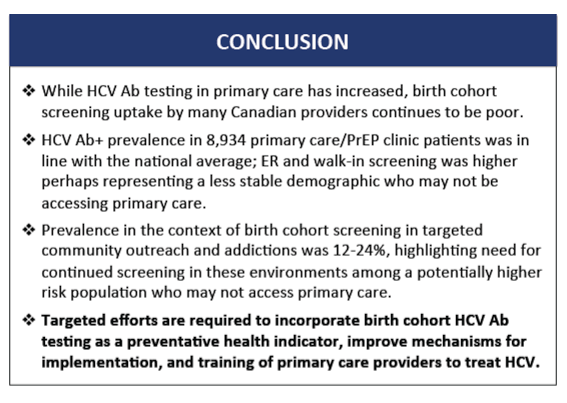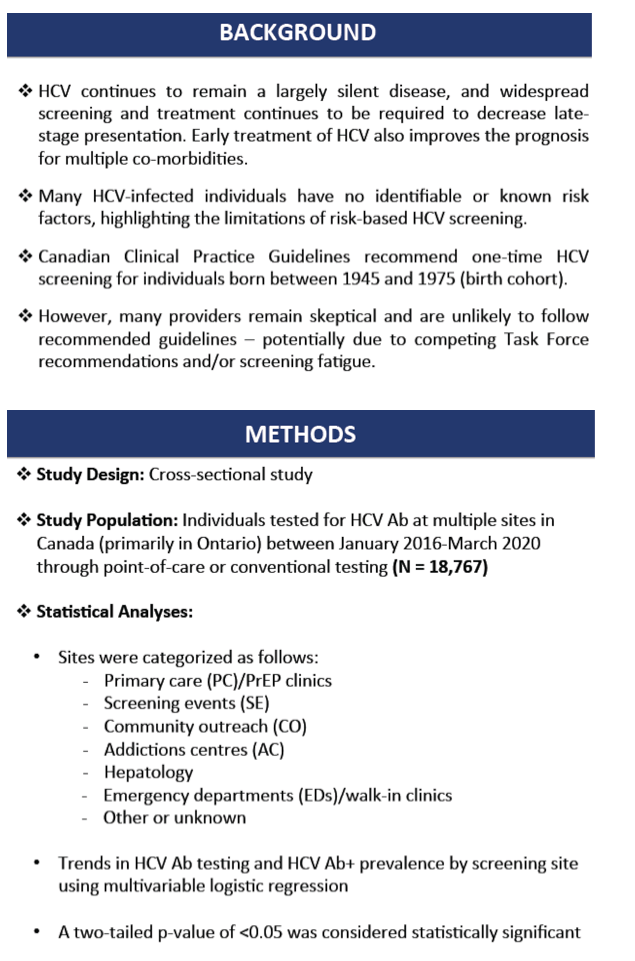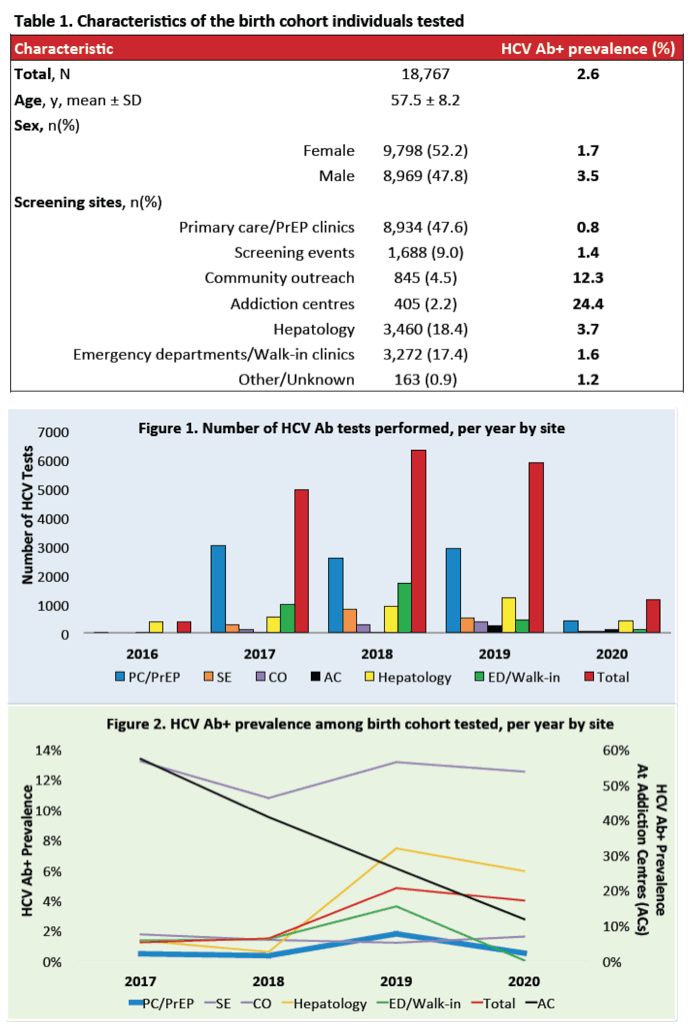 |
 |
 |
| |
REAL-WORLD ANALYSIS OF BIRTH COHORT HEPATITIS C ANTIBODY PREVALENCE IN ONTARIO, CANADA
|
| |
| |
AASLD 2020 Nov 11-16 virtual
Reported by Jules Levin
Mia Biondi1, Grishma Hirode1, Camelia Capraru1, Brett Wolfson-Stofko1, Steven M Friedman2, Kathy Bates3, Tony Mazzulli4, Joshua V. Juan5, Aaron Vanderhoff1, Joel Karkada1, Hemant Shah1, Bettina E. Hansen1, Jordan J. Feld1 and Harry L.A. Janssen1, (1)Toronto Centre for Liver Disease/ Viral Hepatitis Care Network (VIRCAN), University Health Network, (2)Department of Emergency Medicine, University Health Network, (3)Emergency Department, Toronto Western Hospital, University Health Network, (4)Department of Laboratory Medicine and Pathobiology, University of Toronto, (5)Albany Medical Clinic
Conclusion: Although recommended in national guidelines, birth cohort screening uptake by Canadian providers remains a challenge . Not surprisingly, our data demonstrated that HCV Ab prevalence was very high in those seen in addictions centres - potentially a demographic of individuals who may be less likely to access primary care . However, the Ab prevalence was higher than the national average in primary care; highlighting the importance and value of continued birth cohort screening in this setting.

abstract
REAL-WORLD ANALYSIS OF BIRTH COHORT HEPATITIS C ANTIBODY PREVALENCE IN ONTARIO, CANADA
Mia Biondi1, Grishma Hirode1, Camelia Capraru1, Brett Wolfson-Stofko1, Steven M Friedman2, Kathy Bates3, Tony Mazzulli4, Joshua V. Juan5, Aaron Vanderhoff1, Joel Karkada1, Hemant Shah1, Bettina E. Hansen1, Jordan J. Feld1 and Harry L.A. Janssen1, (1)Toronto Centre for Liver Disease/ Viral Hepatitis Care Network (VIRCAN), University Health Network, (2)Department of Emergency Medicine, University Health Network, (3)Emergency Department, Toronto Western Hospital, University Health Network, (4)Department of Laboratory Medicine and Pathobiology, University of Toronto, (5)Albany Medical Clinic
Background: HCV continues to remain a largely silent disease, where widespread screening and treatment will be required to decrease late-stage presentation . As many individuals have no risk factors, Canadian Clinical Practice Guidelines recommend one-time HCV screening for anyone born between 1945 and 1975 . Unfortunately, many Canadian primary healthcare providers remain skeptical and have not adopted this practice - potentially related to competing Task Force recommendations, or screening fatigue . We conducted a real-world analysis of HCV antibody (Ab) prevalence among a large number of individuals born between 1945 and
Methods: HCV Ab testing was conducted at multiple sites in Canada (primarily in Ontario), between January 2016-March 2020 through point-of-care or conventional testing . We analyzed trends in HCV Ab testing and prevalence by site using multivariable logistic regression . Sites were categorized as screening events, emergency departments/walk-in clinics, primary care, community outreach, addictions centres, or other .
Results: 18,767 individuals born between 1945-1975 were tested (mean age 57 .5±8 .2 years, 47 .8% male) . Overall HCV Ab+ prevalence was 2 .6% . HCV Ab+ prevalence was highest in addictions centres (23 .7%), followed by community outreach (12 .9%) . Majority of testing occurred in primary care (9,248 tests), with a prevalence of 1 .3% . Considerable testing also occurred at ED/walk-in clinics (n=3,435), with a prevalence of 1 .6% . Compared to screening events, odds of a HCV Ab+ test result was 6 .5 times higher (95% CI 4 .1-10 .4; p<0 .001) during community outreach, and 14 .0 times higher (95% CI 9 .1-21 .7; p<0 .001) at addictions centres . Younger birth cohort individuals (OR 0 .98; 95% CI 0 .97-0 .99; p<0 .001), and males (vs . females: OR 1 .8; 95% CI 1 .4-2 .1; p<0 .001) also had higher odds of HCV Ab+ prevalence .
Conclusion: Although recommended in national guidelines, birth cohort screening uptake by Canadian providers remains a challenge . Not surprisingly, our data demonstrated that HCV Ab prevalence was very high in those seen in addictions centres - potentially a demographic of individuals who may be less likely to access primary care . However, the Ab prevalence was higher than the national average in primary care; highlighting the importance and value of continued birth cohort screening in this setting.



|
| |
|
 |
 |
|
|